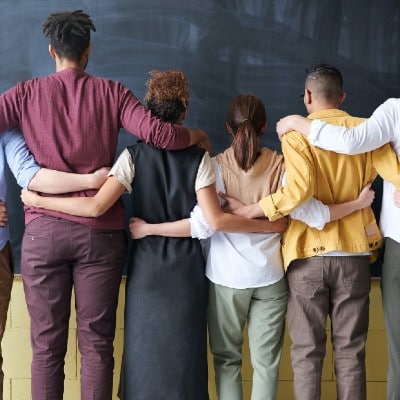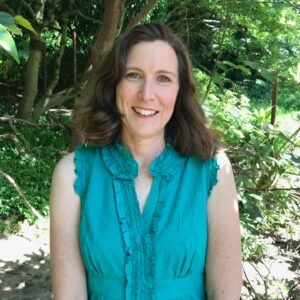 By Angelica “Heidi” Brehm
By Angelica “Heidi” Brehm
Before my migraine disease caused me daily pain and disability, I was an elementary school teacher. I intentionally taught my students about people who shared their backgrounds, challenges, and differences who managed to dream big and accomplish amazing things. I integrated these role models throughout my curriculum because I believed it would increase my students’ success. So why did it take me so long to search for role models for myself? Why didn’t I seek out examples of people with migraine, chronic pain, or other life-altering challenges who lived successful lives? Maybe it’s because it was hard to believe that something so basic could have such a powerful effect on my own success.
When I was struggling to come to terms with a life that included nonstop pain, I didn’t see role models. The people I worked with pushed through their health problems and managed to keep their jobs, but I couldn’t. Growing up, I was exposed to only a couple of people who had health challenges and they were able to work, raise a family, and exist in a way that seemed very “normal” to me, but my life didn’t feel “normal” anymore. I didn’t know anyone who needed Social Security disability or Medicare to survive, but I did. Everyone in my social circle seemed able-bodied and functional, but I wasn’t. I felt very alone.
With help from therapists and encouragement from family and friends, I expanded my social circle! I began to seek–and still actively try to find people with similar conditions to look up to. I am grateful to the U.S. Pain Foundation, which has been a generous source of many of my role models. They are featured in its INvisible Project publications; attend and lead its support groups, webinars, and trainings; are honored as Pain Warrior of the Month; and work as USPF staff. I am amazed by how easy it has become to find role models and how important they are to my happiness.
Role Models
- Designate Value
By sharing experiences similar to mine, in blogs, podcasts, summits, support groups, and advocacy events, role models show me that my voice and needs matter, too. We may have invisible disabilities and challenges, but we don’t need to be invisible. Just like them, I deserve to be seen, heard, and supported.
- Inspire
When we aren’t in a pandemic, I volunteer at my local children’s hospital. I have the privilege of meeting amazing patients who smile, laugh, and are kind even though they lack the maturity to fully understand their health challenges and have virtually no control over their surroundings or treatment plans. As I observe them approach their days with grace and bravery, I can’t help but think that if they can do it, maybe I can, too. I find myself channeling their strength and positive energy as I go about my own life.
- Bust Myths and Excuses
I create rules in my head about life limitations I must accept, but my role models refute these rules. When things seem impossible for me to achieve, they show that they’re within my grasp.
I used to think that because of my pain and other symptoms I would not be able to perform valuable work. I didn’t believe that I had the stamina or ample brainpower to be able to contribute to society. Then I read A Sudden Illness by Laura Hillenbrand. Laura researched and wrote the award-winning books Seabiscuit and Unbroken along with numerous other articles, from her bed while severely disabled by chronic fatigue syndrome. There went my excuse of not being able to fulfill career ambitions because of health conditions. Laura proved that it was, in fact, possible.
It is true that many relationships fail due to the pressures of chronic pain. But I took that reality and mentally blew it up into the belief that I would never be able to successfully date or have a positive romantic relationship. In the last several years, however, I’ve met many people with health challenges who have wonderful relationships with their significant others or are actively dating and meeting wonderful potential partners. It isn’t easy, but it is possible. The myth that I would have to be alone forever is constantly being busted by my role models.
I also struggle to fathom how I could be a good mother. It feels like I spend almost all of my time focused on taking care of my physical and emotional needs. I don’t know how I would be able to properly care for children, but I have role models who do it every day and prove that this, too, is possible.
- Provide a Road Map to a Full Life
I can sometimes feel like a victim at the mercy of a disease that causes my life to be limited and incomplete. I find role models, however, that reveal strategies and resources they use to do the activities that they aren’t willing to give up.
Being able to do volunteer work is very important to me, but as my migraine disease progressed it became more and more difficult to find volunteer roles that I could tolerate. Thinking it would be a good fit, I pursued volunteering at a children’s hospital, but my hopes were squashed when I found out parking wasn’t available for volunteers and the street parking had too short a time limit. I’d have to take the bus, which would extend the amount of time I would need to be active and expose me to noise and smells that would increase my migraine symptoms to the point that the activity was no longer tenable. Luckily, I remembered an article I had read by Kerrie Smyres, an INvisible Project contributor and founder of The Daily Headache, about how getting a disabled parking permit had made her life less disabling. Maybe it could for me, too. I applied and qualified for a placard which allows me to park close to the hospital without a time limit restriction. Kerrie showed me how to solve my problem so I could do something I love.
It wasn’t until I watched an interview with Eileen Jones, the founder of Miles for Migraine, that I decided to apply to Headache on the Hill, a USPF-supported event where participants ask Congress to address the needs of people with chronic headache disease. I wanted to attend, but couldn’t conceive of how I would be able to manage all the migraine triggers to which the experience would expose me. Eileen shared that the event was hard for her too, so much so that she needed to go to the Capitol Infirmary to rest during one of her visits, but it was worth it. Learning that there was an infirmary where I could recover and that I would be surrounded by other people who have or treat migraine, who could help me if I required it, gave me the insight and confidence I needed to apply and participate.
I used to sing “This Little Light of Mine” with my second-grade students. I loved the song’s message of determination, the proclamation that no matter what life throws at me, I will be my best possible self and let my light shine.
When facing pain and hardship, it is easy for the light inside that represents our enthusiasm for life, our sense of purpose, our independence, and our feelings of self-worth, to dim or even sputter out. Some days, when I look inside myself, all I see is darkness, excuses, and roadblocks.
Then I interact with someone special, energized, and shining bright. I see her climbing over roadblocks and I see others making their way around them. I see people carving, pebble by pebble, an opening through stone walls and suddenly there is light in the darkness, the excuses fade, and the roadblocks are transformed. They are still challenges, but I believe it is possible to overcome them.
Role models are so important because they help me find the light inside of myself and show me how to increase its brightness.
Role models help me to SHINE.
 Angelica “Heidi” Brehm lives in the San Francisco Bay Area. She developed migraine 28 years ago and has since experienced varying degrees of pain and other disabling symptoms. When not managing her disease, Heidi enjoys hiking and volunteering, including as a U.S. Pain Foundation advocate and ambassador. Though her life has been impacted by chronic pain, participating in advocacy, taking part in educational events, such as USPF’s webinars, and connecting with peers have helped her find new purpose, hope, and joy.
Angelica “Heidi” Brehm lives in the San Francisco Bay Area. She developed migraine 28 years ago and has since experienced varying degrees of pain and other disabling symptoms. When not managing her disease, Heidi enjoys hiking and volunteering, including as a U.S. Pain Foundation advocate and ambassador. Though her life has been impacted by chronic pain, participating in advocacy, taking part in educational events, such as USPF’s webinars, and connecting with peers have helped her find new purpose, hope, and joy.
